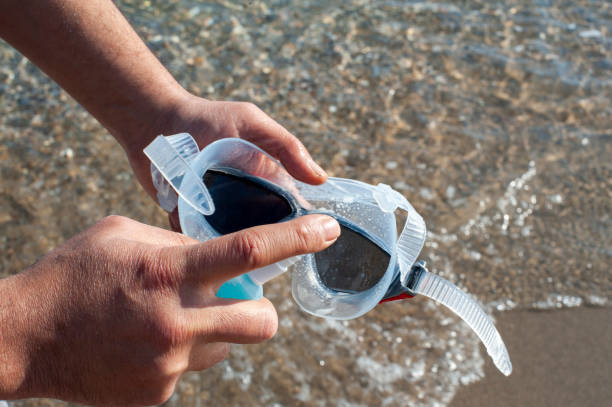Qu'est-ce qu'une combinaison technique pour la natation ? Les combinaisons techniques ne sont pas de simples maillots de bain ; elles sont spécialement conçues pour améliorer vos performances en natation de compétition. Ces combinaisons avancées sont essentielles pour améliorer votre vitesse et réduire la traînée lors de vos déplacements. Dans cet article, nous explorerons l'univers des combinaisons techniques, leurs avantages, leurs principes de fonctionnement et comment elles peuvent propulser votre expérience de natation vers de nouveaux sommets.

Que sont les combinaisons technologiques ?
Les combinaisons techniques sont soigneusement confectionnées avec des matériaux de pointe pour minimiser la résistance à l'eau ou la traînée. Le tissu spécialisé utilisé, comme le tissu innovant LZR Pulse de Speedo, est conçu pour réduire les frottements dans l'eau. Ce matériau unique, doté de petites rainures parallèles imitant la peau d'un requin, améliore l'hydrodynamisme du nageur en créant une surface plus lisse pour l'écoulement de l'eau.
Afin d'optimiser les performances, les combinaisons techniques sont conçues avec une coupe ajustée qui épouse le corps et réduit la traînée pendant la compétition. Leur construction sans coutures garantit une circulation optimale de l'eau sur le corps du nageur. De plus, leur déperlance empêche l'absorption excessive d'eau, permettant ainsi aux nageurs de conserver leur vitesse et leur agilité en piscine.
Avantages des combinaisons technologiques
Les avantages des combinaisons techniques vont au-delà de leur simple élégance. De la compression musculaire à la réduction de la traînée, ces combinaisons offrent de nombreux avantages qui peuvent améliorer considérablement les performances des nageurs. Voici un aperçu détaillé de la façon dont les combinaisons techniques peuvent vous aider en piscine.
Compression musculaire
L'un des principaux avantages du port d'une combinaison technique est la compression qu'elle procure aux muscles du nageur. Sa coupe ajustée favorise une meilleure circulation sanguine et une élimination plus rapide des déchets métaboliques et de l'acide lactique des muscles. En comprimant des groupes musculaires spécifiques, comme ceux des cuisses pour les hommes, les combinaisons techniques améliorent le maintien musculaire et la performance globale pendant les courses.
Réduction de la traînée
Les combinaisons techniques réduisent efficacement la traînée dans l'eau grâce à leurs matériaux hydrophobes et à leur coupe près du corps. Ces caractéristiques combinées créent une surface sans frottement permettant aux nageurs de se déplacer dans l'eau avec une résistance minimale. Ainsi, les nageurs subissent moins de résistance, ce qui leur permet de nager plus rapidement et d'améliorer leur efficacité à chaque mouvement.
Amélioration de la flottabilité
Un autre avantage des combinaisons techniques est leur capacité à améliorer la flottabilité dans l'eau. Leur conception spécifique permet aux nageurs de maintenir une position plus élevée dans l'eau, réduisant ainsi la traînée et favorisant des mouvements efficaces à chaque longueur. En améliorant la flottabilité, les combinaisons techniques permettent aux nageurs de conserver leur énergie et de se concentrer sur l'optimisation de leur vitesse et de leur technique pendant les compétitions.
Qui devrait utiliser des combinaisons techniques ?
Tous les nageurs n'ont pas besoin d'une combinaison technique, mais pour les nageurs de haut niveau, ces combinaisons peuvent faire toute la différence. Voyons qui en bénéficie le plus et les considérations d'âge.
Nageurs de compétition
Les combinaisons techniques sont spécialement conçues pour les nageurs de compétition qui souhaitent atteindre des performances optimales en compétition. Ces vêtements avancés confèrent aux athlètes un avantage concurrentiel en améliorant leur vitesse, leur agilité et leur efficacité dans l'eau. Que vous vous entraîniez pour une compétition ou que vous cherchiez à améliorer vos records personnels, porter une combinaison technique peut avoir un impact significatif sur vos performances globales.
Restrictions d'âge
Il est essentiel de noter que l'utilisation de combinaisons techniques en natation de compétition est soumise à des restrictions d'âge. Dans des pays comme les États-Unis, ces maillots de bain de haute technologie sont généralement interdits aux nageurs de 12 ans et moins. Cette réglementation vise à maintenir l'équité et l'équilibre entre les jeunes athlètes, tout en garantissant l'égalité des chances à tous les participants pendant les courses.
Comment fonctionnent les combinaisons de natation Tech ?

Comprendre la technologie des combinaisons techniques peut vous aider à évaluer leur impact sur la performance. De la technologie de compression aux matériaux hydrophobes, découvrons la science qui rend ces combinaisons efficaces.
Technologie de compression
La technologie des combinaisons techniques est fascinante, notamment leurs capacités de compression. Découvrez comment ces combinaisons soutiennent vos muscles et améliorent votre circulation sanguine pendant vos séances de natation.
Soutien musculaire
En portant une combinaison technique, vos muscles bénéficient d'un soutien essentiel grâce à la technologie de compression intégrée au tissu. Ce soutien contribue à améliorer vos performances en favorisant une meilleure circulation sanguine et une élimination plus rapide des déchets métaboliques et de l'acide lactique. La coupe ajustée de la combinaison assure une bonne compression musculaire, vous permettant de nager plus efficacement et de réduire la fatigue.
Amélioration du flux sanguin
La technologie de compression des combinaisons techniques soutient non seulement vos muscles, mais améliore également la circulation sanguine dans tout le corps. En favorisant une circulation optimale, ces combinaisons contribuent à l'apport d'un sang riche en oxygène à vos muscles, améliorant ainsi leur endurance et leurs performances globales pendant les courses. Cette meilleure circulation sanguine favorise également l'élimination des sous-produits métaboliques, vous permettant ainsi de maintenir des performances optimales tout au long de votre nage.
Matériaux hydrophobes
L'un des éléments clés de l'efficacité des combinaisons techniques est l'utilisation de matériaux hydrophobes. Ces tissus avancés repoussent l'eau, vous assurant une nage fluide et légère. Découvrons comment ces matériaux contribuent à réduire la traînée et à améliorer vos performances.
Hydrofugation
Les combinaisons techniques sont fabriquées à partir de matériaux hydrophobes qui repoussent l'eau au contact, vous permettant de glisser sans effort dans la piscine. Leur caractère déperlant empêche l'absorption excessive d'eau, vous permettant ainsi de nager en toute légèreté. Cette caractéristique réduit la résistance à l'eau, vous permettant de bouger rapidement et efficacement sans être alourdi par la résistance de l'eau.
Réduction de la friction
Grâce à l'intégration de matériaux hydrophobes, les combinaisons techniques réduisent efficacement les frottements lors de vos déplacements dans l'eau. La surface lisse créée par ces matériaux minimise la force de résistance exercée sur vous, permettant des mouvements plus fluides et des temps de nage plus rapides. Grâce à la réduction des frottements, vous pouvez vous concentrer sur l'optimisation de votre vitesse et de votre technique sans qu'une résistance inutile ne freine votre progression.
Avantages psychologiques
Les avantages des combinaisons techniques vont au-delà de la performance physique ; elles offrent également des bénéfices psychologiques importants. Du renforcement de la confiance en soi à l'instauration d'un état d'esprit de performance, le port d'une combinaison technique peut avoir un impact positif sur votre approche mentale de la natation. Voici comment ces aspects psychologiques jouent un rôle crucial dans votre performance globale.
Renforcement de la confiance
Porter une combinaison technique peut considérablement booster votre confiance avant une course. Leur design élégant et leurs fonctionnalités avancées insufflent aux nageurs de compétition un sentiment de préparation. En entrant dans le starting-block, vêtu d'une combinaison haute performance, vous dégagez une confiance qui peut influencer positivement votre état d'esprit et votre approche de la course.
Mentalité de performance
Les bienfaits psychologiques d'une combinaison technique vont au-delà de la confiance en soi : ils favorisent un état d'esprit axé sur la performance. Savoir que vous portez un maillot de bain de pointe, conçu pour des résultats optimaux, peut améliorer votre concentration et votre détermination pendant les compétitions. Cet état d'esprit renforcé vous permet de canaliser votre énergie vers la réalisation de vos objectifs en piscine avec un dévouement sans faille.
Combinaison technique ou maillot de bain traditionnel : quelle est la différence ?
En natation de compétition, le choix du maillot de bain peut avoir un impact significatif sur vos performances. Les maillots techniques et les maillots traditionnels offrent chacun des avantages et des caractéristiques uniques. Comprendre ces différences peut aider les nageurs à faire des choix éclairés concernant leur équipement.
Conception et matériaux
Les combinaisons techniques sont fabriquées avec des matériaux avancés et performants, conçus pour réduire la traînée et améliorer l'hydrodynamisme. Ces combinaisons sont souvent composées de tissus comme le LZR Pulse de Speedo ou d'autres mélanges exclusifs imitant la peau de requin, créant une surface plus lisse pour l'écoulement de l'eau. Leur construction est généralement sans coutures ou avec des coutures collées pour minimiser la résistance à l'eau.
En revanche, les maillots de bain traditionnels sont généralement fabriqués à partir de matières comme le nylon, le polyester ou l'élasthanne. Bien que ces tissus soient durables et confortables, ils n'offrent pas le même niveau de déperlance et de réduction de la traînée que les maillots techniques. Les maillots de bain traditionnels comportent souvent plus de coutures et une coupe plus ample, ce qui peut augmenter la traînée dans l'eau.
Avantages en termes de performance
L'un des principaux avantages des combinaisons techniques réside dans leur technologie de compression. Ces combinaisons sont ajustées et appliquent une compression ciblée sur les principaux groupes musculaires, comme les cuisses et le tronc. Cette compression améliore la circulation sanguine, réduit les oscillations musculaires et renforce le soutien musculaire, ce qui améliore les performances et réduit la fatigue.
Les maillots de bain traditionnels ne disposent pas de cette fonction de compression. Bien qu'ils offrent un ajustement confortable pour la natation et l'entraînement quotidiens, ils n'offrent pas les mêmes avantages en termes d'amélioration des performances. Les maillots traditionnels privilégient le confort et la durabilité plutôt que l'optimisation des performances en compétition.
Hydrodynamique et réduction de la traînée
Les combinaisons techniques sont spécialement conçues pour réduire la traînée. Leurs matériaux hydrophobes repoussent l'eau, permettant aux nageurs de glisser dans l'eau avec une résistance minimale. La coupe ajustée et profilée des combinaisons techniques garantit également l'absence de zones lâches susceptibles de créer une traînée.
Les maillots de bain traditionnels, en revanche, ne privilégient pas autant la réduction de la traînée. Les matériaux utilisés peuvent absorber davantage d'eau et la coupe peut créer une résistance supplémentaire. Bien que ce ne soit pas un problème majeur pour les séances de natation occasionnelles ou d'entraînement, cela peut impacter les performances en compétition.
Coût et durabilité
Les maillots de bain techniques sont généralement plus chers que les maillots de bain traditionnels en raison des matériaux et de la technologie de pointe utilisés pour leur fabrication. Ils sont également moins durables, souvent conçus pour un nombre limité de courses. La fragilité du tissu exige une manipulation et un entretien minutieux.
Les maillots de bain traditionnels sont plus abordables et durables, ce qui les rend idéaux pour l'entraînement quotidien et la natation de loisir. Plus résistants à l'usure et plus faciles d'entretien, ils constituent un choix pratique pour un usage régulier.
Comment choisir un maillot de bain technique ?

Choisir une combinaison technique adaptée peut avoir un impact significatif sur vos performances en piscine. Voici les facteurs clés à prendre en compte pour choisir une combinaison technique :
Ajustement et compression
La coupe d'une combinaison technique est cruciale. Une combinaison bien ajustée doit être ajustée et comprimer les principaux groupes musculaires, améliorant ainsi la circulation sanguine et réduisant la fatigue musculaire. Privilégiez une combinaison qui vous aille comme une seconde peau sans être inconfortable. Chaque marque peut proposer de légères variations de taille ; essayez plusieurs modèles ou consultez les tableaux des tailles pour trouver la taille idéale.
Tissu et matériau
Les combinaisons techniques sont fabriquées à partir de matériaux hydrophobes avancés qui repoussent l'eau et réduisent la traînée. Parmi les matières les plus populaires, on trouve le LZR Pulse de Speedo, la série Carbon d'Arena et le tissu Avictor de TYR. Ces tissus sont légers et conçus pour améliorer l'hydrodynamisme. Choisissez une matière adaptée à vos besoins, en tenant compte de la sensation et de la souplesse du tissu.
Construction des coutures
La construction des coutures joue un rôle essentiel pour minimiser la traînée. Privilégiez les combinaisons avec des coutures collées ou soudées plutôt que des coutures piquées, car elles créent une surface plus lisse et réduisent la résistance à l'eau. Les coutures collées améliorent également la durabilité et la longévité de la combinaison en minimisant le risque d'effilochage.
Dos ouvert vs dos fermé
Le choix entre une combinaison technique dos ouvert et dos fermé dépend de vos préférences et de votre confort. Les combinaisons dos ouvert offrent une plus grande liberté de mouvement et sont souvent préférées par les nageurs qui privilégient la souplesse. Les combinaisons dos fermé offrent davantage de compression et de maintien, notamment au niveau du tronc et du bas du dos, ce qui peut être bénéfique pour certains nageurs.
Marque et modèle
Différentes marques proposent différents modèles adaptés à des besoins et à des styles de nage spécifiques. Recherchez et comparez les maillots de bain des plus grandes marques, comme Avant-gardeSpeedo, Arena, TYR et Mizuno. Consultez les avis et les retours d'autres nageurs pour comprendre les points forts et les points faibles de chaque modèle. Vérifiez également si la marque propose des maillots de bain adaptés à votre style de nage ou à votre distance.
Budget
Les combinaisons techniques peuvent être coûteuses, allant de $200 à $600. Évaluez votre budget à l'avance et comparez les avantages des combinaisons haut de gamme à ceux des options plus abordables. Si les combinaisons haut de gamme offrent des fonctionnalités avancées, les combinaisons milieu de gamme peuvent néanmoins offrir d'excellentes performances.
Règlements et restrictions
Consultez le règlement de votre fédération de natation ou de votre compétition concernant les combinaisons techniques. Certaines organisations imposent des restrictions sur les types et les matériaux des combinaisons, notamment pour les jeunes nageurs. Assurez-vous que la combinaison que vous choisissez est conforme à ces règles pour éviter toute disqualification.
Essai et tests
Si possible, essayez le maillot de bain dans l'eau avant de prendre votre décision finale. Certains magasins ou marques de natation proposent des périodes d'essai ou des piscines. Cela vous permet de tester le maillot en nageant et de vous assurer qu'il répond à vos attentes en matière de confort et de performance.
Comment laver un maillot de bain technique ?
Bien entretenir une combinaison technique est essentiel pour préserver ses performances et sa longévité. Suivez ces étapes pour la maintenir en parfait état après chaque baignade.
Lavage des mains
Pour préserver la qualité et la longévité de votre combinaison technique, il est essentiel de suivre les instructions de lavage. Commencez par rincer la combinaison à l'eau froide après chaque utilisation afin d'éliminer le chlore et autres produits chimiques susceptibles d'endommager le tissu. Pour le lavage, privilégiez le lavage à la main plutôt qu'en machine. Remplissez une bassine ou un évier d'eau froide et ajoutez une lessive douce spécialement conçue pour les tissus délicats. Plongez la combinaison dans de l'eau savonneuse et agitez-la délicatement pour un nettoyage en profondeur sans étirer ni abîmer le tissu.
Après avoir laissé tremper la combinaison quelques minutes, frottez délicatement du bout des doigts les zones visiblement sales ou tachées. Évitez de frotter trop fort, car cela pourrait abîmer le tissu. Une fois la combinaison propre, videz l'eau savonneuse et remplissez la bassine d'eau froide propre pour rincer. Remuez délicatement la combinaison pour éliminer les résidus de savon jusqu'à ce que l'eau soit claire.
Éviter les détergents
Lorsque vous choisissez une lessive pour votre combinaison technique, privilégiez toujours une lessive douce, sans produits chimiques ni additifs agressifs. Les lessives agressives peuvent altérer l'intégrité du tissu et compromettre ses performances à long terme. Évitez également l'eau de Javel ou les assouplissants, car ces produits peuvent endommager les matériaux spécifiques utilisés dans les combinaisons techniques.
Optez plutôt pour des lessives spécialement formulées pour les tissus délicats ou les vêtements de sport. Ces nettoyants doux éliminent efficacement les impuretés sans endommager les maillots de bain haute performance, comme les combinaisons techniques. N'oubliez pas : moins, c'est mieux en matière de lessive : une utilisation excessive peut laisser des résidus qui altèrent les propriétés hydrophobes du tissu et son efficacité globale à réduire la résistance à l'eau.
Séchage à l'air
Après avoir lavé votre combinaison technique, il est essentiel de la sécher correctement pour conserver sa compression et son étanchéité. Posez une serviette propre à plat sur une surface et placez la combinaison lavée dessus. Enroulez la serviette avec la combinaison à l'intérieur, en appuyant doucement pour absorber l'excès d'eau sans tordre ni essorer le tissu. Déroulez la serviette et transférez la combinaison humide sur une autre serviette sèche à plat.
Laissez votre combinaison Tech sécher complètement à l'air libre, à l'abri de la lumière directe du soleil ou de sources de chaleur comme les radiateurs ou les sèche-linges. Le séchage à l'air libre peut altérer sa forme et compromettre son ajustement à long terme ; privilégiez donc le séchage à plat. Assurez une ventilation adéquate de la zone de séchage afin d'éviter l'accumulation d'humidité, source de moisissures.
Stockage approprié
Lorsque vous rangez votre combinaison technique entre deux utilisations, évitez de la plier ou de la froisser excessivement, car cela pourrait endommager son élasticité et sa compression. Posez-la plutôt à plat dans un tiroir ou sur une étagère, où elle ne sera pas comprimée par d'autres objets. Si vous devez la suspendre pour des raisons d'espace, utilisez des cintres rembourrés à larges épaules pour répartir uniformément le poids sur le vêtement.
Pour protéger votre Tech Suit des accrocs et des déchirures, pensez à le placer dans un sac en filet respirant avant de le ranger dans votre placard ou votre commode. Cette protection supplémentaire prévient les dommages accidentels et permet à l'air de circuler autour de la combinaison, évitant ainsi les odeurs de moisi. En suivant ces conseils d'entretien simples pour le lavage, le séchage et le rangement de votre Tech Suit, vous prolongerez sa durée de vie et garantirez des performances optimales à chaque fois que vous irez à la piscine.
Conclusion
En résumé, qu'est-ce qu'une combinaison technique de natation ? C'est un vêtement haute performance conçu pour améliorer la compétition en améliorant la compression musculaire, en réduisant la traînée et en augmentant la flottabilité. Les combinaisons techniques offrent des avantages à la fois physiques et psychologiques, ce qui les rend indispensables pour les nageurs expérimentés qui visent des performances optimales. Un entretien approprié, comme le lavage à la main et le séchage à l'air libre, est essentiel pour préserver l'efficacité de la combinaison. Que vous soyez nageur de compétition ou que vous cherchiez à améliorer votre performance personnelle, investir dans une combinaison technique peut propulser votre expérience de natation vers de nouveaux sommets.
FAQ
Q1 : Quelle est la différence entre une combinaison technique et un maillot de bain ?
Une combinaison technique est conçue pour la natation de compétition et utilise des matériaux avancés pour la compression, la réduction de la traînée et l'hydrodynamisme. Les maillots de bain traditionnels, quant à eux, privilégient le confort et la durabilité, généralement fabriqués dans des tissus comme le nylon ou le polyester. Les combinaisons techniques améliorent les performances, tandis que les maillots de bain classiques sont adaptés à un usage quotidien et à l'entraînement.
Q2 : Les combinaisons de natation techniques en valent-elles la peine ?
Oui, pour les nageurs de compétition, les combinaisons techniques sont un investissement judicieux. Elles offrent des avantages significatifs en termes de performance, comme une meilleure compression musculaire, une réduction de la traînée et une meilleure flottabilité. Ces avantages peuvent conduire à des temps de nage plus rapides et à de meilleures performances globales en compétition, ce qui en fait un investissement précieux pour les athlètes sérieux.
Q3 : Quelle est la durée de vie d'une combinaison technique ?
La durée de vie d'une combinaison technique est relativement courte, généralement entre 6 et 12 courses, selon l'utilisation et l'entretien. La fragilité des matériaux et la conception spécifique les rendent vulnérables à l'usure. Une manipulation soigneuse et un entretien approprié sont donc essentiels pour maximiser leur longévité.
Q4 : Pourquoi les combinaisons de natation techniques sont-elles si chères ?
Les maillots de bain techniques sont coûteux en raison des matériaux de pointe, de la technologie innovante et de la précision de leur fabrication. La recherche et le développement nécessaires à la création de maillots performants, ainsi que les séries limitées et les normes de qualité élevées, contribuent à leur coût plus élevé que celui des maillots de bain traditionnels.
Q5 : Une combinaison technique fermée ou ouverte est-elle meilleure ?
Le choix entre une combinaison technique fermée ou ouverte dépend de vos préférences personnelles et de votre confort. Les combinaisons fermées offrent davantage de compression et de maintien, ce qui peut être avantageux pour certains nageurs, tandis que les combinaisons ouvertes offrent plus de souplesse et de liberté de mouvement. Essayer les deux modèles peut vous aider à déterminer celui qui vous convient le mieux.



